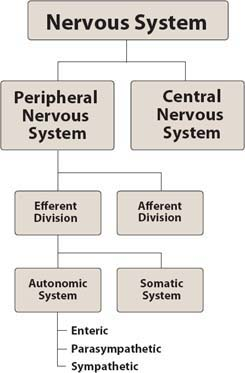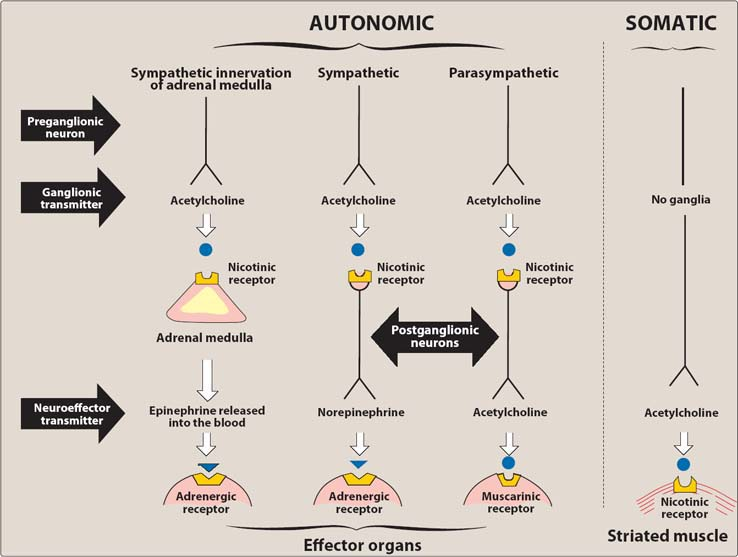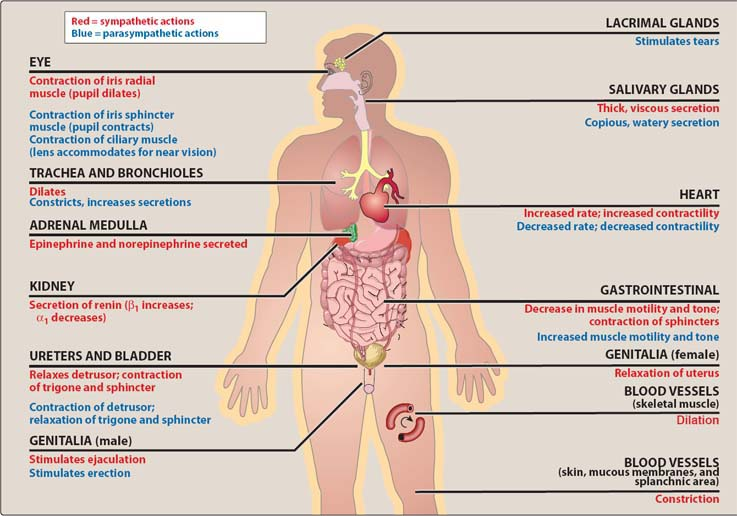Instructions for Side by Side Printing
- Print the notecards
- Fold each page in half along the solid vertical line
- Cut out the notecards by cutting along each horizontal dotted line
- Optional: Glue, tape or staple the ends of each notecard together
Pharmacology: The Autonomic Nervous System
front 1 Endocrine System | back 1 Sends signals to target tissues by varying the levels of bloodborne hormones |
front 2 Nervous System | back 2  Exert its influence by the rapid transmission of electrical impulses over nerve fibers that terminate at effector cells |
front 3 Effector cells | back 3 respond to the release of neuromediator substances. |
front 4 What are autonomic drugs | back 4 Drugs that produce their primary therapeutic effects by mimicking or altering the function of the autonomic nervous system.
|
front 5 Nervous system is divided into how many anatomical divisions? | back 5 2; CNS (Central Nervous System) & PNS (Peripheral Nervous System) |
front 6 What is the CNS | back 6 Composed of brain and spinal cords |
front 7 What is the PNS | back 7 Its subdivided into:
|
front 8 Efferent portion of PNS is divided into 2 major functional subdivisions. What are they? | back 8 Somatic & Autonomic System |
front 9 What is the Somatic system | back 9 thee somatic efferent neurons are involved in voluntary control of functions such as contraction of skeletal muscles essential for locomotion |
front 10 What is the Autonomic system | back 10  regulates everyday requirements of vital bodily functions without the conscious participation of the mind |
front 11 Because of the involuntary nature of the ANS, as well as its function, its also known as? | back 11 Visceral, Vegetative, or Involuntary Nervous System |
front 12 ANS is composed of? | back 12  efferent neurons that innervate smooth muscle of the viscera, cardiac muscle, vasculature, and the exocrine glands; controlling digestion, cardiac output, blood flow, and glandular secretions |
front 13 Anatomy of the ANS:
| back 13 ANS carries nerve impulses fromt he CNS to effector organs by 2 types of efferent neurons:
|
front 14 What are Preganglionic neurons? | back 14 Cell body located within CNS
|
front 15 What are the functions of the ganglia | back 15 its a relay station between a preganglionic neuron and second nerve cell called Postganglionic
|
front 16 What are Postganglionic neurons? | back 16 Cell body originating in Ganglion
|
front 17 Anatomy of the ANS:
| back 17 They are important in the reflex regulation.
|
front 18 Efferent ANS is divided into what 3 Nervous systems? | back 18 Sympathetic
|
front 19 Anatomy of the Efferent ANS:
| back 19 Originate in CNS and emerge from 2 different spinal cord regions
|
front 20 Anatomy of the Efferent ANS:
| back 20 Thoracolumbar division (because of its location) |
front 21 Anatomy of the Efferent ANS:
| back 21 highly branched, enabling one pregangionic neuron to interact with many postganglionic neurons
|
front 22 Anatomy of the PNS:
| back 22 Arise from Cranial nerves:
|
front 23 Anatomy of the PNS:
| back 23 Accounts of 90% of preganglionic parasympathetic fibers in the body
|
front 24 Anatomy of the Efferent ANS:
| back 24 Craniosacral Division
|
front 25 So Difference between Parasympathetic and Sympathetic Pre & Post ganglionic nerves? | back 25 Sympathetic: Pre = Short
|
front 26 Anatomy of the PNS:
| back 26 3rd division of ANS
|
front 27 Anatomy of the PNS:
| back 27 functions independently of CNS & controls motility, exocrine and endocrine secretions, and microcirculation of GI tract.
|
front 28 Function of SNS | back 28 Adjust in response to stressful situation; fear, trauma, hypoglycemia, cold, & exercise |
front 29 Sympathetic actions of SNS | back 29  Eye: Contract of Iris radial muscle (Pupil dilates)
|
front 30 Parasympathetic action of SNS | back 30  Eye: Contraction of Iris sphincter muscle (pupil contract) Contract of ciliary muscle (lens accomodate for near vision)
|
front 31 Different Stimulations of Sympathetic & Parasympathetic | back 31 Sympathetic: "Fight or Flight" with sympathetic output (diffuses because postganglionic neurons may innervate more than one organ)
|
front 32 Effects of stimulation of the sympathetic division | back 32 Output = increase HR & BP
|
front 33 Symapthetic "Flight or Flight" | back 33 Changes experienced by the body during emergencies:
|
front 34 stimulation of the parasympathetic division | back 34 Maintains homeostasis of body
|
front 35 Role of CNS in control of autonomic functions | back 35 does not require sensory input from peripheral structures to provide info on state of affairs in body
|
front 36 Role of CNS: Reflex arcs | back 36 most afferent impulses are translated into reflex response w/o involving consciousness
|
front 37 Emotions from ANS | back 37 Stimuli evokes strong feelings; rage, fear, pleasure, and can modify the activities of ANS |
front 38 Innervations by ANS | back 38 Dual: most innervated by both divisions of ANS
|
front 39 What organs ONLY receive sympathetic innervation? | back 39 adrenal medulla
|
front 40 Somatic Nervous system | back 40 efferent somatic nervous system difference from autonomic in that single myelinated motor neuron from cns travels directly to skeletal w.o mediation of ganglia
|
front 41 Summary of differences between Sympathetic & Parasympathetic | back 41 Sympathetic Parasympathetic
|
front 42 Somatic Nervous system innervates: | back 42 skeletal muscles.
|
front 43 What are some Chemical Signalling between cells | back 43 Nuerotransmission in ANS
|
front 44 Chemical Signalling between cells
| back 44 Specialized endocrine cells secrete hormones into bloodstream where they travel throughout body
|
front 45 Chemical Signalling between cells
| back 45 most cells secrete chemicals that act locally; on cells in their immediate environment
|
front 46 Neurotransmitters | back 46 Distinct anatomic units with no structual continuity
|
front 47 How is release of neurotransmitters triggered? | back 47 Release of neurotransmitters is triggered by arrival of the action potential which
|
front 48 Membrane receptors of Nuerotransmitters | back 48 too hydrophilic to penetrate the lipid bilayers of target cell plasma membranes
|
front 49 what are the types of neurotransmitters (6) | back 49 Norepinephrine
|
front 50 What 2 neurotransmitters are the primary chemical signals in ANS? | back 50 Acetylcholine & Norepinephrine |
front 51 What are the neurotransmitters that are primary chemical signals of the CNS | back 51 dopamine
|
front 52 Acetylcholine | back 52 ANS fibers can be divided into 2 groups based on chemical nature of neurotransmitter released
|
front 53 Acetylcholine continued | back 53 is the neurotransmitter for Adrenal medulla
|
front 54 Norepinephrine & Epinephrine | back 54 when transmitted its adrenergic (another name for epinephrine)
|
front 55 Transmitters and Receptors:
| back 55  Preganglionic transmitter: Acetylcholine
|
front 56 Transmitters and Receptors:
| back 56 Preganglionic transmitter: Acetylcholine
|
front 57 Transmitters and Receptors:
| back 57 Preganglionic transmitter: Acetylcholine
|
front 58 Transmitters and Receptors:
| back 58 No Ganglia
|
front 59 All preganglionic fibers of the autonomic nervous system use the neurotransmitter ______________. | back 59 Acetylcholine |
front 60 The major neurotransmitter for sympathetic
| back 60 Norepinephrine |
front 61 Stimulation of sympathetic innervation to the eye causes contraction of the ____________ muscle and, therefore, __________ of the pupil | back 61 Radial
|
front 62 The rate-limiting step in the synthesis of norepinephrine is ___________. | back 62 formation of DOPA by tyrosine b-hydroxylase |
front 63 The major pathway for the termination of the action of norepinephrine is ______________ | back 63 Its reuptake |
front 64 The actions of acetylcholine released from parasympathetic fibers in viscera are mediated by _______ receptors. | back 64 Muscarinic |
front 65 Adrenergic receptors in the heart are predominantly
| back 65 beta 1 |
front 66 Stimulation of alpha 1 receptors causes predominantly ____________ of blood vessels. | back 66 Constriction |
front 67 Stimulation of the sympathetic nervous system causes ___________ in gluconeogenesis and glycogenolysis. | back 67 An increase |
front 68 Stimulation of the b2
| back 68 relaxation |
front 69 Baroreceptors maintain what? | back 69 Baroreceptors maintain normal blood pressure
|